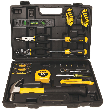One of the more common wall covering options has long been sheet paneling. This great option gives you the look of wooden walls at a fraction of the cost. Best of all, there are some other issues that help make sheet paneling an attractive choice for homeowners and do-it-yourself enthusiasts. Some of these include the durability of the paneling, the relatively easy installation process, and even the ability to replace damaged sections easily as well. If you find yourself in need of replacing sheet paneling in your home, simply follow these steps, and you will quickly have a new wall.
- Remove the trim. Being as careful as you possibly can, remove the baseboard and top molding of the paneling. The best way that you can do this is by using a wallboard or putty knife to create a small opening, and then inserting a small pry bar into the gap. Gently remove the nails and the trim.
- Remove the paneling, Take a framing square or straight edge, and draw a line on the panel that is about three to four inches from the damaged section (on either side if applicable). With the line in place, have a friend hold the straight edge or framing square along the line. Use a linoleum knife and begin cutting along the line. Be sure that you use a decent amount of pressure, but not too much since you don't want to damage the wall underneath the paneling. If done properly, you should be able to cut through the paneling in two or three passes. Begin removing the paneling by peeling it off. Considering how much glue was used, you may end up breaking off the paneling in chunks or sections, and you may need to use a hammer and chisel to remove some o it. As you do though, be careful not to damage the wall underneath. Use a paint scraper to remove any old adhesive that is still remaining on the wall. Inspect (if possible) the vapor barrier of the wall, and repair it if necessary.
- Match the paneling. Once you have remove the paneling, take a decent sized section to your local home improvement store. Use the section to help you find a match to the paneling that you have in your home. It should be as close to color, texture, and so on as possible.
- Cut and prep. With your new paneling in hand, cut and prepare it to fit into missing section on the wall. Once you have the paneling cut to size, begin placing adhesive onto the back of it. Typically, you do this by applying zigzagging beads of the glue from top to bottom, every 16 inches, and about two inches away from the edges.
- Place paneling, and replace trim. With the help of a friend, place the paneling onto the wall. Be sure that the seams line up on both sides as you do this. Have your friend hold the paneling in place while you nail the paneling to the wall. Once you have the paneling in place, begin replacing the trim that you had removed earlier. If you would like, you can wait for a day or tow prior to replacing the trim to allow the adhesive to completely dry. After the trim is back in place, you may want to fill any nail holes with wood filler.
Author Bio
Lee Wyatt
Contributor of numerous Tips.Net articles, Lee Wyatt is quickly becoming a regular "Jack of all trades." He is currently an independent contractor specializing in writing and editing. Contact him today for all of your writing and editing needs! Click here to contact. Learn more about Lee...
What's with the Blue Headlights?
Get the insider information on why blue headlights are making a splash in the automotive world.
Discover More
Building a Bottle Garden
If you like the look of a terrarium, but don't like the size you may want to look into building a bottle garden. It's not ...
Discover More
Common Tomato Ailments
Tomatoes are a great plant that can be loads of fun to grow. However, there is just one draw back to them. That drawback ...
Discover More
More Home Improvement Tips
Finishing Drywall
Just because you have hung your drywall doesn't mean that you are finished. Finishing drywall is a completely different ...
Discover More
Fixing a Hole in a Wall
Holes in a wall are ugly, nasty, and down right embarrassing. Here is how you can fix those holes, and be proud of your ...
Discover More
Finding Studs in Walls
Sometimes it's not easy to locate studs since they are mostly concealed behind plaster and other parts of the wall. While ...
Discover More

Comments